The most terrible thing about War, I am convinced, is its monuments, — the awful things we are compelled to build in order to remember the victims. In the South, particularly, human ingenuity has been put to it to explain on its war monuments, the Confederacy. Of course, the plain truth of the matter would be an inscription something like this: ‘Sacred to the memory of those who fought to Perpetuate Human Slavery.’
W.E.B. Dubois [1]
W.E.B. DuBois, the prominent Black intellectual who co-founded the NAACP (among his many other achievements) was in his early sixties when he took a vacation traveling through the southern United States in 1931. Everywhere he went, he encountered racism: segregated train stations and rail cars, segregated schools and universities. Reminders of the Civil War dotted the landscape; he was particularly frustrated by the ubiquitous Confederate monuments—public structures built to commemorate the people who fought to secede from the United States to protect the institution of slavery—with inscriptions praising these generals and politicians for their dedication to “liberty.” He knew well that it was not the love of liberty but the desire to continue enslaving Black people that led southern states to seek independence.
Map of Public Symbols of the Confederacy. Southern Poverty Law Center, “Whose Heritage: Public Symbols of the Confederacy,” 2021.
Coming to terms with monuments
DuBois had reason to complain about symbols honoring the Confederacy: they were everywhere in the South, and they still are. At least 1,700 schools, roads, buildings, municipalities, and monuments have been named after or dedicated to Confederates since the Civil War. Of these, about 800 are monuments: physical structures specially constructed for the purpose of remembering and honoring people or events, including statues, arches, obelisks, and other forms of public memorial art. Most were put up after 1900 (at least fifty years after the conflict ended), and relatively few have come down, despite the recent outcry over the monuments in the wake of White supremacist violence and the Black Lives Matter movement. Between 2015 and 2021 fewer than 40 Confederate monuments were removed. The vast majority of sites “sacred to the memory of those who fought to perpetuate human slavery” remain in place. [2]
But it is not only Confederate monuments that deserve scrutiny; the history written in stone and bronze by the victorious United States deserves as much critical analysis as that of the defeated Confederacy. For example, several prominent U.S. Army generals who have been honored with monuments for their actions in the Civil War and during Reconstruction pursued genocidal wars against Indigenous peoples (both those nations that were allied with the Confederacy and those that were not) in the American West during those same eras. Should these monuments remain in place?
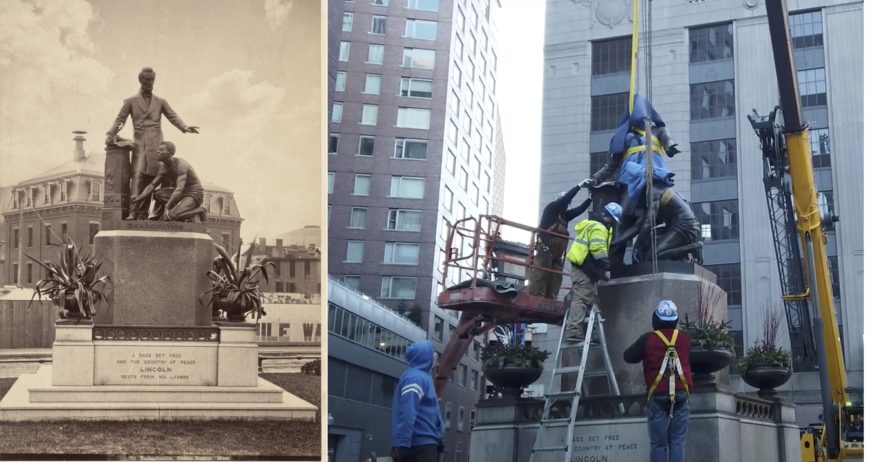
Left: Thomas Ball, Emancipation Group (recasting of Freedmen’s Memorial), Park Square, Boston, Massachusetts, c. 1877–95, albumen print (Boston Public Library); right: removal of the statue from Park Square, Boston in December 2020 (courtesy Boston City TV). The image of the Freed Slave was based on Archer Alexander, who was emancipated in September 1863 in recognition of his service to the United States and the disloyalty of his enslaver under the terms of the Confiscation Acts.
Statues of Abraham Lincoln have also been sites of recent controversy, both because of Lincoln’s actions towards Indigenous peoples and because many Lincoln statues seem to depict him “granting” emancipation to passive Black people. In fact, U.S. Army and northern monuments as a whole tended to minimize or erase the role of Black people in the war and the importance of emancipation to U.S. victory, focusing instead on the efforts of white generals and white common soldiers.
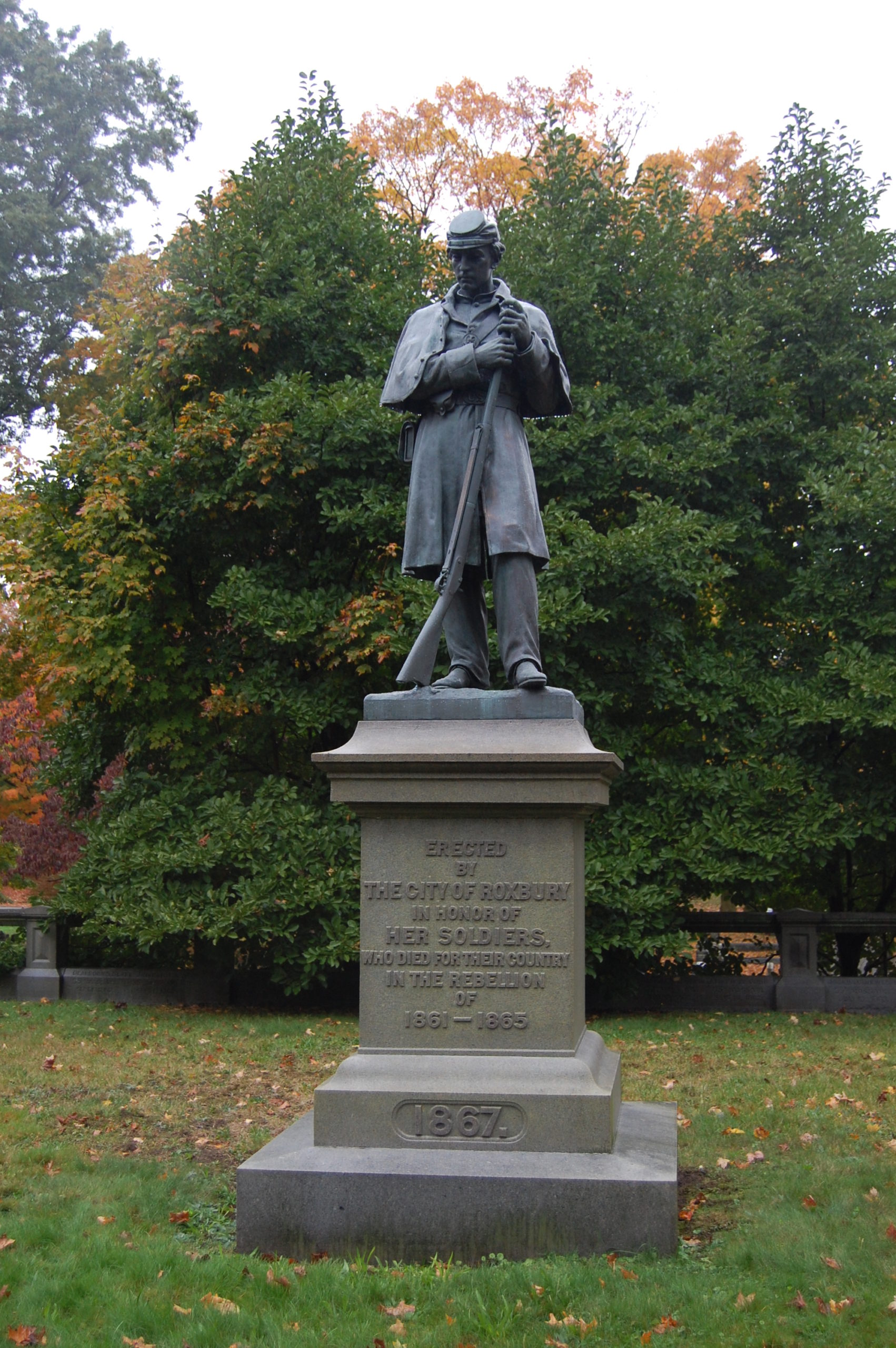
Martin Milmore (sculptor) and Ames Manufacturing Company (founder), Roxbury Soldier Monument, Forest Hills Cemetery, Boston, 1867 (photo: Sarah Beetham, CC BY-NC-ND 2.0)
Both white northerners and southerners erected monuments that concentrated on the common white soldier at the expense of other participants in the war. The most common Civil War monument is the “citizen soldier” monument, an image of a single white volunteer soldier in a relaxed pose, rifle at ease, standing atop a column or pedestal, such as this monument to the soldiers of Roxbury, Massachusetts. [3] Depicting one enlisted soldier pensively leaning against his upturned rifle, Roxbury’s monument was not unique; in fact, there were at least seven casts made of this statue in order to provide similar monuments for the dead or veterans of other northern towns. [4]
These monuments appeared in large numbers across the country—in cities and small towns, and in both the North and the South (in fact, often the only thing that separates Union and Confederate figures are the uniforms and inscriptions). These lone figures were so popular that they were mass produced in both bronze and stone, and even sold through catalogs. These broke with European military monument tradition since they were dedicated not to the extraordinary achievements of a military or political leader, but to the common soldier. This soldier was almost always white, however—even though Black and white soldiers had both fought and died in the war, and thousands of Indigenous men fought on both sides of the conflict. These memorials satisfied a need to come to terms with the astounding numbers of dead on both sides, but they also created a standardized image of a soldier willing to sacrifice his life for his country—and that soldier was decidedly white.
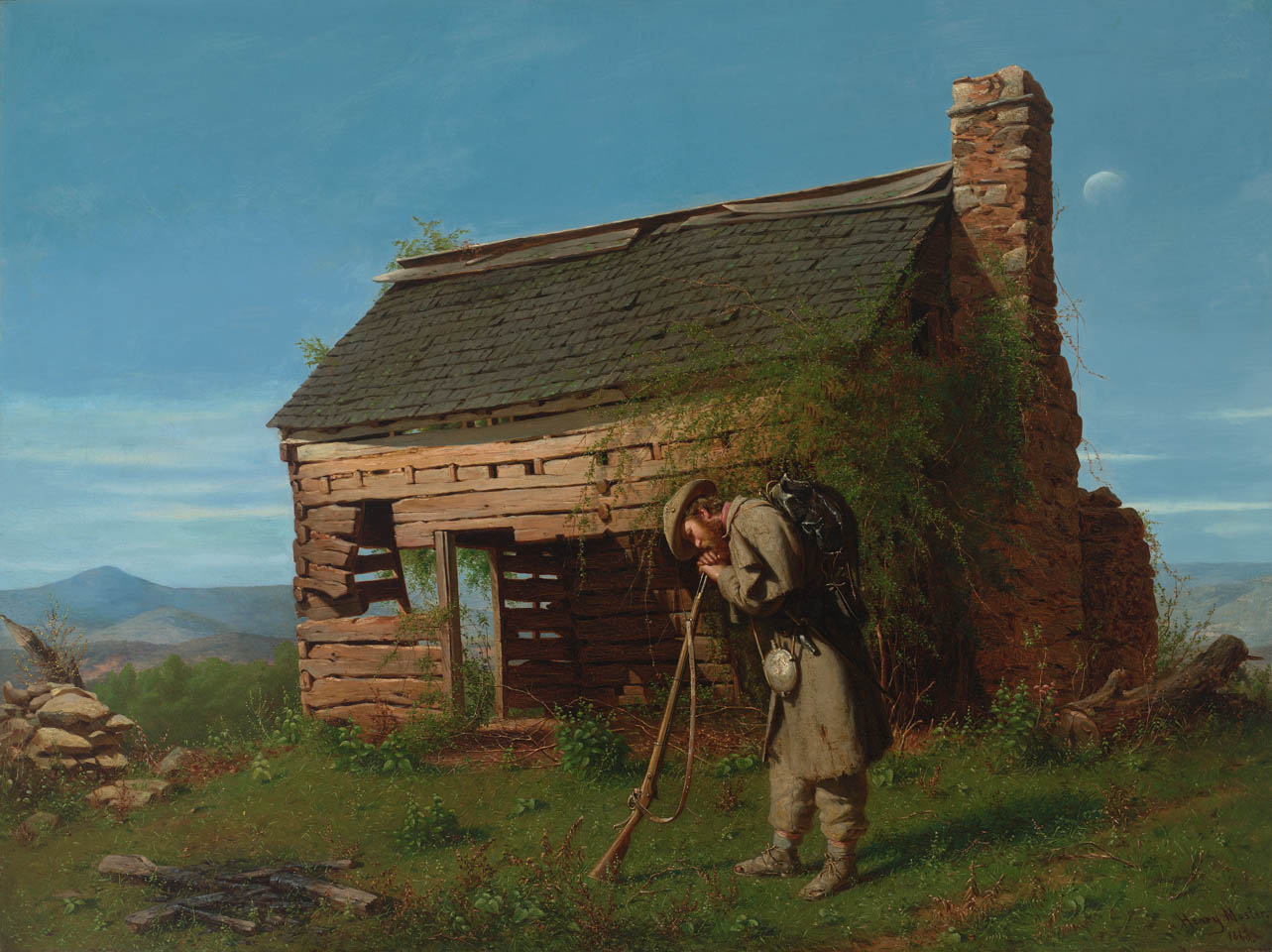
Henry Mosler, The Lost Cause, 1868, oil on canvas, 91.44 cm x 121.92 cm (The Johnson Collection)
Art and Civil War memory
After the Civil War, both sides took pains to craft their own narratives of the conflict: why it happened, what had happened, and what it all meant. These narratives helped the public make sense of the physical and psychological wounds inflicted by war, helping those who had lost limbs or loved ones justify their sacrifice in the service of a higher purpose. Former Confederates in particular sought explanations for their defeat, and found them in a book by Virginia journalist Edward A. Pollard called The Lost Cause: A New Southern History of the War of the Confederates. Published in 1866, just one year after the end of the war, Pollard’s book began to articulate what would come to be known as “The Lost Cause:” a mythology that rewrote the causes of the Civil War to erase the role of slavery and to instead emphasize the heroism of white southern combatants. The painter Henry Mosler’s melancholy 1868 image of a veteran stooped over his rifle standing before the ruin of a modest house, presumably his former home, became a popular expression of a lost past in the years following the war.
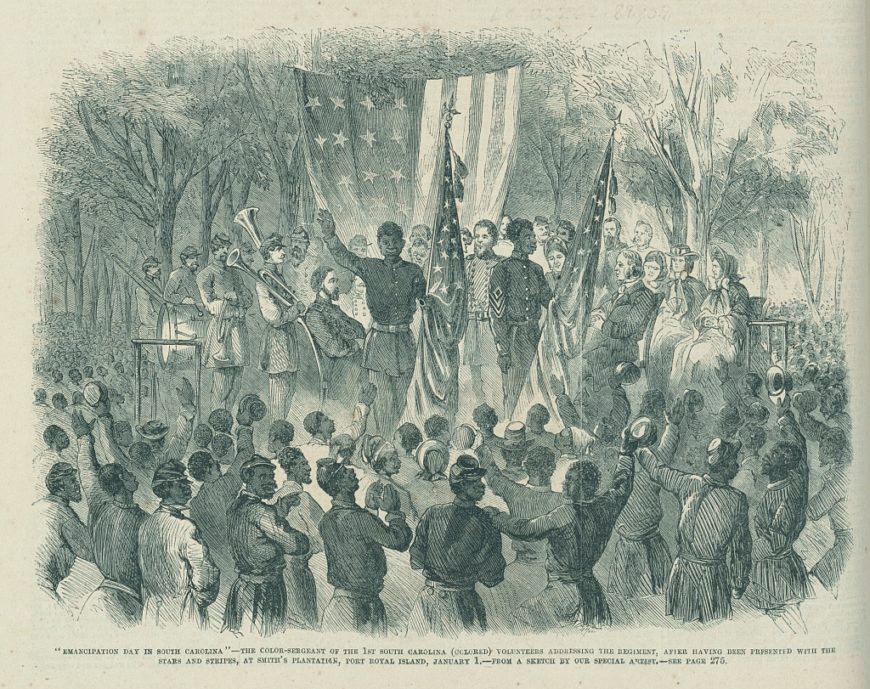
The First South Carolina Volunteers’ color guard addressing a joyful crowd of African Americans after the reading of the Emancipation Proclamation on January 1, 1863. “‘Emancipation Day in South Carolina’—the Color-Sergeant of the 1st South Carolina (Colored) Volunteers addressing the regiment, after having been presented with the Stars and Stripes, at Smith’s plantation, Port Royal Island, January 1 / From a sketch by our special artist.,” Frank Leslie’s Illustrated Newspaper, January 24, 1863, wood engraving, 40 x 27 cm (Library of Congress)
The Lost Cause was more than wistful nostalgia. With it came efforts to quash southern Black celebrations of Confederate defeat and the end of slavery, like parades and dances held on the Fourth of July and on Emancipation Day. [5] The victorious white northerners also focused their attention on some aspects of the war and not others, downplaying emancipation and eventually coming to accept many facets of the Lost Cause as truth. Neither side acknowledged the service of Indigenous soldiers, thousands of whom fought on behalf of the United States or the Confederacy.
Visual culture was central to the creation and dissemination of these narratives. Public monuments celebrated the achievements of some individuals and not others (notably, white women and people of color, but also certain politicians and generals for reasons not always connected with their wartime service). Popular imagery of the war that circulated in prints and paintings promoted some emotional and political responses to the war, but not others (grief and gratitude for emancipation, but not anger or demands for citizenship). Notably, both the narratives of the war and the art representing it in popular culture changed over time, as politics evolved and generations shifted.
To understand the political and social landscapes that shaped Civil War memory—the environment in which commemorative art was created—we must first examine the events following the end of the war.
The end of the Civil War
Scholars traditionally date the end of the Civil War to April 9, 1865, when Confederate General Robert E. Lee surrendered to U.S. Army General Ulysses S. Grant at Appomattox Court House, Virginia. In fact, the end of the war was a slow, sporadic process riddled with chaos and confusion. It took months before every soldier and sailor put down their weapons, as news of Lee’s surrender and U.S. President Abraham Lincoln’s assassination spread slowly across the country and the world. The last land battle of the war took place more than a month after Appomattox. Not until June 19, 1865, did word of the Emancipation Proclamation reach the enslaved residents of Galveston, Texas; Black Americans have celebrated the anniversary of this date each year as “Juneteenth,” which was recognized as a federal holiday in 2021. The Indigenous allies of the Confederacy, led by Cherokee Chief and Brigadier-General Stand Watie, surrendered in late June. The last Confederate ship surrendered in late November, when it made port in Liverpool, England.
The political and social ramifications of the war’s end were equally unclear. By the end of 1865, the rebellion had been defeated and the Thirteenth Amendment to the U.S. Constitution had outlawed slavery for good. But what would happen to the four million formerly enslaved Black people who were navigating freedom after being denied property, wages, access to family, and education? What would become of the members and the lands of the “Five Civilized Tribes” (Cherokees, Choctaws, Chickasaws, Creeks, and Seminoles, now more commonly known as the Five Tribes of Oklahoma or simply Five Tribes), who had allied with the Confederacy? How would the U.S. government reintegrate the South’s white population—that had so recently taken up arms against it—into the American body politic? Would power and wealth be distributed more equitably now that slavery was gone, or would the old hierarchies of race and class simply continue?
The twelve years following the Civil War are called the Reconstruction era, when both the infrastructure and the society of the South were rebuilt. Reconstruction was a complex process that changed over time: just like any major policy initiative in the United States today, its details were negotiated at the local, state, and national levels, and its contours altered as power changed hands in Congress and the White House. Scholars have filled thousands of books with analysis of this period, making it difficult to summarize, nevertheless we include a brief overview here so that readers can compare the outline of historical events to the commemoration processes that accompanied them.
A brief history of Reconstruction and its aftermath
Immediately after the war’s end in 1865, southern state governments resumed many aspects of Black surveillance and policing that had characterized life under slavery, passing Black Codes that restricted the movement of Black people and punished men convicted of “vagrancy” with unpaid “apprenticeships” (essentially a return to slavery). Members of the U.S. Congress, however, were incensed by these flagrant attempts to reverse the Thirteenth Amendment. They put forward a new Constitutional amendment guaranteeing the citizenship of Black people, the Fourteenth Amendment, and placed nearly all of the South under military occupation until each state ratified both the Thirteenth and Fourteenth Amendments. In addition, Congress put forward the Fifteenth Amendment, ratified in 1870, which guaranteed the right to vote for Black men.
With access to political power at last, Black citizens of the South voted into office politicians who represented their interests. More than 600 Black men were elected to state and national office during Reconstruction, including two senators.
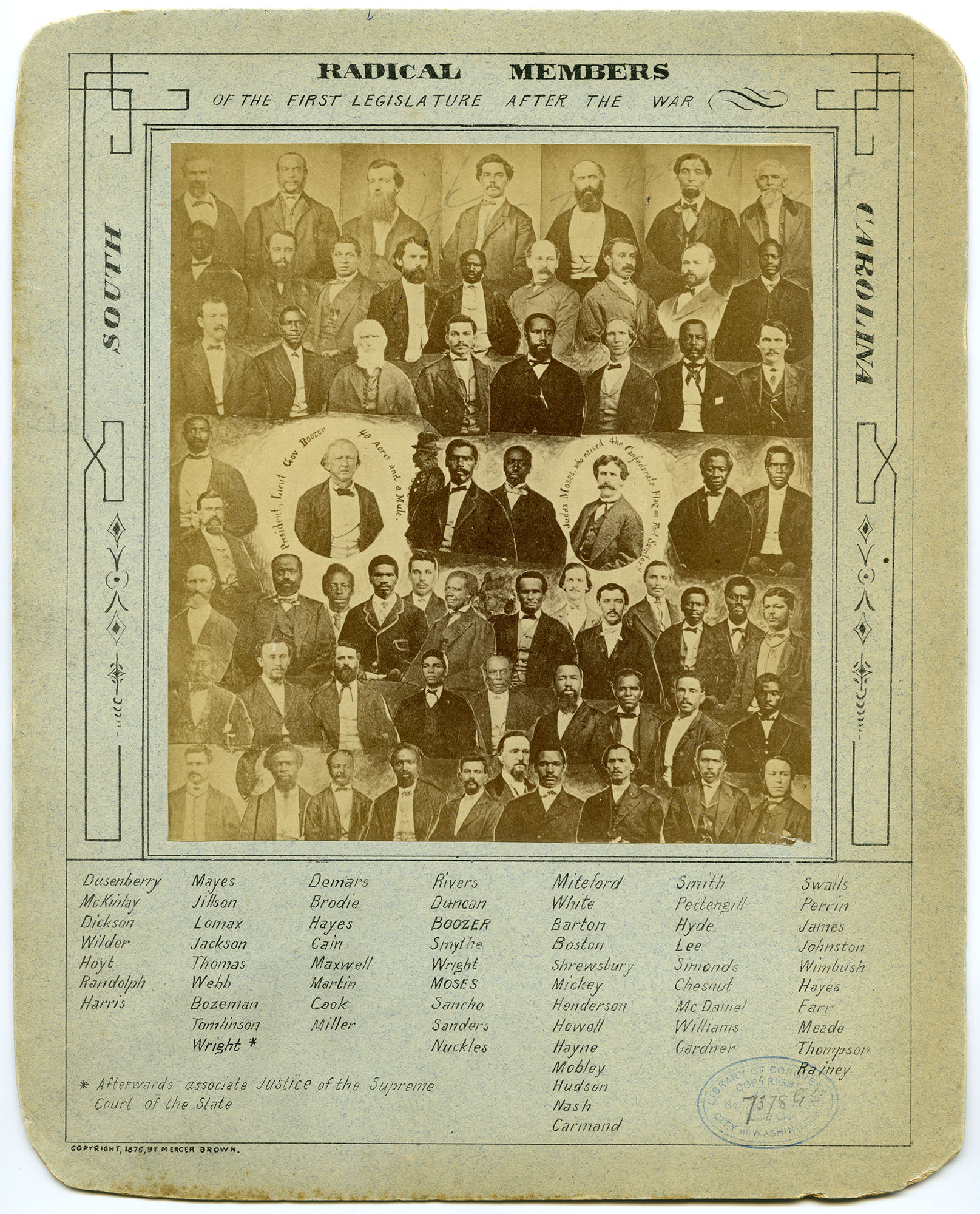
Photomontage inscribed with the names of members of the first South Carolina legislature following the Civil War, which was circulated by Confederate sympathizers. Radical members of the first legislature after the war, South Carolina, c. 1876, photomontage (Library of Congress)
The image above, entitled “Radical Members,” is a photomontage of portraits of members of the 1868 South Carolina legislature—the first to be elected after South Carolina was readmitted to the United States following the Civil War. This image (and others like it, showing newly elected Black and white officials), was widely circulated to stoke fears among South Carolina’s white population. The word “Radical” in the title was pejorative and was used by Confederate sympathizers to undermine efforts to foster racial equality. Two white men are singled out near the center of the composition. Each is given extra space and is framed by an inscription. On the left the handwritten words read, “President, Lieut Gov Boozer—40 Acres and a Mule.”
Lemuel Boozer, a Republican, was Lieutenant Governor from 1868–70 and is here linked to promises of land redistribution that many whites opposed. To the right is a portrait of Franklin Moses, Jr., famous for lowering the U.S. flag at Fort Sumter following the Confederate attack that began the war. Whether or not Moses did this, he was later seen as a scalawag, which then meant a white southerner who supported Reconstruction. Here the framing text reads, “Judas Moses. Who raised the Confederate Flag on Fort Sumter!!” The addition of the name Judas is a reference to Franklin Moses’s perceived treachery for supporting Reconstruction just as the apostle Judas betrayed Christ. It was also an anti-Semitic attack (Moses’s father was Jewish).

Hubbard & Mix, Freedmen and teachers in front of the Beaufort Library (detail from stereograph), c. 1862, albumen silver print, 8 x 17 cm (Library of Congress)
The Freedmen’s Bureau, a governmental agency dedicated to aiding ex-slaves, opened schools to teach literacy to the formerly enslaved (who had been forbidden to learn to read and write under slavery) and worked to reunite families separated during slavery. In the photograph above, a large number of Black children pose in front of white adults before the Neoclassical porch of the Beaufort Library on the South Carolina coast. White plantation owners and their families abandoned the town in 1861 after the battle of Port Royal, leaving behind thousands of enslaved people including an estimated 2,100 children.

Charles Milton Bell, Studio portrait of Charlotte L. Forten Grimke, c. 1870–79, carte-de-visite, 9 x 6.5 cm (Schomburg Center for Research in Black Culture, New York Public Library)
By March 1862 the first white missionary teachers, who can be seen in the photograph above standing beside white U.S. Army officers (right center), arrived. Within one year, Charlotte Forten, then a 25-year-old Black missionary teacher and poet from Philadelphia, began to teach freed Black children.
Despite these advances, white supremacists in the South mounted intense opposition to Black civil rights. White supremacist paramilitary organizations like the Ku Klux Klan and the White League, which frequently included Confederate veterans, terrorized Black citizens and their white allies. They sought to prevent Black people from obtaining political, social, or economic power, asserting that while slavery had ended, the racial hierarchy remained. Although the federal government attempted to intervene by prosecuting Klan members in the early 1870s, by the end of the decade the federal government had agreed to remove the remaining U.S. troops from the former Confederacy.
In the west, the Indigenous peoples who had allied with the Confederacy, either directly (like the Five Tribes) or indirectly (like Apaches and Kiowas who had agreed to raid U.S. territory and U.S. Army supplies rather than those of the Confederates) also had to negotiate their defeat with the U.S. government. They were forced to sign new treaties promising to free any Black people they enslaved and permit railroad companies to build through their territories, in addition to ceding land and moving to reservations. But even these concessions proved inadequate for land-hungry white settlers, who soon encroached upon Indigenous lands and applied for protection from the U.S. Army when Indigenous people resisted.
After the U.S. Army departed from the South, its commanders turned west. William Tecumseh Sherman—famous for his 1864 March to the Sea that played a key role in defeating the Confederates—became Commanding General of the U.S. Army in 1869 and advocated wholesale genocide of Native peoples. The same men who had attempted to protect formerly enslaved Black people from the Klan drove Indigenous people onto reservations and killed those who resisted the theft of their lands.
By the 1890s, southern states reversed the advances of Reconstruction, reinstated white supremacist governments, and introduced voter suppression tactics barring Black people from participating in the political process. The white American population as a whole (North and South) generally rejected the notion that non-white peoples deserved equal rights. The U.S. Supreme Court permitted southern towns and businesses to segregate public facilities, ruling that “separate but equal” schools, transportation, and hospitals did not violate the 14th Amendment. Although civil rights activists never stopped challenging these provisions, it was not until the mid-20th century that major victories in the courts and Congress restored Reconstruction-era voting rights and outlawed segregation.
The essays
The two essays in this section examine the role of art in commemorating the Civil War: how that art contributed to northern and southern narratives of the war’s causes and significance and the ways that both Black and Indigenous activists have pushed back against those narratives.
The first essay, “The Lost Cause and Confederate memory,” examines how monuments, paintings, and popular prints contributed to the mythology of white southern valor and created hostile public spaces dedicated to reinforcing white supremacy.
The second essay, “Abraham Lincoln and northern memory,” looks at how images of emancipation and Black military contributions were erased in favor of a reassertion of white racial supremacy.
Notes:
[1] W.E.B. DuBois, “The Perfect Vacation,” The Crisis 40, no. 8 (August 1931), p. 279.
[2] Data from the Southern Poverty Law Center, “Whose Heritage: Public Symbols of the Confederacy,” 2021. See also Karen Cox, No Common Ground: Confederate Monuments and the Ongoing Fight for Racial Justice (Chapel Hill: The University of North Carolina Press, 2021), pp. 6–8; and Hilary Green, Confederate Monument Removal mapping project.
[3] For a full discussion of the citizen soldier monuments, see Kirk Savage, Standing Soldiers, Kneeling Slaves: Race, War, and Monument in Nineteenth-Century America (Princeton, NJ: Princeton University Press, 1997); and Sarah Beetham, “‘An Army of Bronze Simulacra’: The Copied Soldier Monument and the American Civil War,” Nierika: Revista de Estudios de Arte 4, no. 7 (January–June 2015), pp. 34–45.
[4] Beetham, “An Army of Bronze Simulacra,” p. 36.
[5] Ethan J. Kytle and Blaine Roberts, Denmark Vesey’s Garden: Slavery and Memory in the Cradle of the Confederacy (New York: The New Press, 2018), pp. 28–35.
Additional resources
Read more about the remarkable life of Archer Alexander.
Read the national monument audit from The Monuments Lab.
Read selections from the journal of Charlotte Forten.
W.E.B. DuBois, Black Reconstruction in America, 1860–1880 (New York: Russell & Russell, 1935).
Explore the National Museum of African American History & Culture’s exhibition “Make Good the Promises: Reconstruction and Its Legacies.”
Eric Foner, Reconstruction: America’s Unfinished Revolution, 1863–1877, updated edition (New York: Harper, 2014).
Learn more about W.E.B. DuBois’s efforts to visualize institutionalized racism with infographics.


